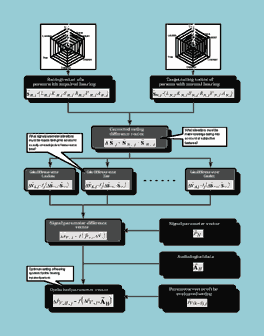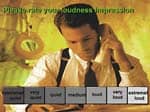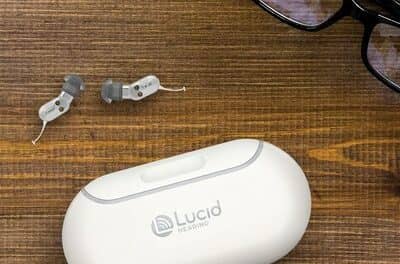|
P a n e l i s t s |
| Marcia Dugan, Panel Moderator Marcia Dugan is a past-president of the Self Help for Hard of Hearing People Inc (SHHH) national board of trustees, and currently serves on the board of the NY State Association of SHHH. A former director of public affairs at the National Technical Institute for the Deaf, she is the author of Living with Hearing Loss, released by Gallaudet University Press, Washington, in 2003. |
| Ruth Bernstein, MS Ruth Bernstein is the Travel Committee chair and past coordinator of advocates for better communication (a.b.c.), allied with the League for the Hard of Hearing in New York City. She compiled a.b.c.’s Travel Kit, incorporating her professional and travel experiences for the benefit of people with hearing loss. |
| Lise Hamlin Lise Hamlin has worked as an advocate and a volunteer for SHHH, and professionally as the access and advocacy coordinator at the League for the Hard of Hearing. She has chaired the Government Affairs Committee of the SHHH board of trustees and the Legislative Affairs Committee of the board of directors of the NY State Association of SHHH. |
| Patricia Irr Patricia Irr holds a degree in social work from the Rochester Institute of Technology. She is a past president of SHHH Rochester and currently works as part of the team in the One Voice Project, which provides technical information and education regarding hearing accessibility in houses of worship. |
| George Kosovich George Kosovich is employed as a Vocational Rehabilitation Program Specialist in the Deafness and Communicative Disorders Branch of the Rehabilitation Services Administration at the US Department of Education. An active member of the SHHH since 1981, he currently serves as the Maryland SHHH State Coordinator and as the leader of his local chapter. |
| Donna S. Wayner, PhD Donna S. Wayner is president of Hear Again Inc, Latham, NY, and the former director of The Hearing Center at the Albany Medical Center Hospital in Albany, NY. She is the founder and professional advisor of HEAR, a self help group in the Albany Region, and professional advisor to the NY State Association of SHHH. Correspondence can be addressed to [email protected]. |
Hearing in Restaurants
By Marcia Dugan
Many social and business activities take place at mealtimes and in restaurants. Most people choose restaurants for the quality and variety of food, service, ambience, and price. People who are hard of hearing need to take other things into consideration when dining out to increase their ability to understand conversation. Below are suggestions for making restaurant dining more enjoyable:
1) Call ahead, if possible. Tell the person accepting the reservation that you are hard of hearing and would like a table in a quiet spot (you may need to explain that “quiet” means little or no noise from behind, not near an air-conditioning/heating unit or a loudspeaker). A corner table or a booth in the back is often a good choice.
2) Timing is important. The best times for lower noise levels are before and after peak hours. Not only are restaurants crowded at noon and 6:30pm, but the service is also usually rushed.
3) Choose a restaurant with good lighting. Some restaurants have low levels of lighting, which can make it difficult to speechread and see facial expressions. Music often accompanies soft lights. Don’t hesitate to ask the waiter to turn down the music.
4) Choose the seat at the table that will maximize your ability to hear the conversation. If you hear better in one ear than the other, ask your companion or the person you most wish to hear to sit on the better side. A seat against a wall is a good choice because you will not have sound coming to you from behind. If the restaurant has windows or bright lighting, be sure that your back is to the light so that your companions’ faces are not in the shadows.
5) Restaurants often offer specials. Ask the waiter if these are written down so that you can read them; if not, ask the waiter to stand closer to you so that you can speechread and hear better.
6) If you own an FM system or another one-on-one communicator, be sure to take it with you to facilitate conversation with your dinner companions and the waiter.
7) If you are unable to make a reservation beforehand and find yourself in a noisy restaurant or at a noisy table where communication would be difficult, and it is important that you be able to understand what is being said, consider leaving and finding another restaurant.
While most restaurant personnel are helpful and understanding, you need to tell them that you have a hearing loss and ask what they can do to help you hear. When they provide help, show your gratitude; when they don’t, you can make your dissatisfaction known, courteously, but firmly.
For those who enjoy fast food dining, the drive-thru procedure can be challenging since you are unable to see the face of the person taking your order, and the audio system often is poor quality. In order to take advantage of this convenient way to get a meal without leaving your automobile, be prepared to place your order when you hear the “squawk” at the drive-up box. Speak clearly and provide information as completely as possible, ending with the statement, “that’s all, thank you.” Drive on to the payment window, where the cashier can answer any questions about your order.
Travel
By Ruth D. Bernstein, MS
Traveling rates high on the list of stressful situations for people with hearing loss. There are so many need-to-hear situations involved that planning and enjoying a trip can seem overwhelming and frightening. Here are some ideas about traveling which can help lessen your pre-trip anxiety level and raise your enjoyment quotient while you are on the road.
Always identify yourself as someone with a hearing loss even if you are traveling with a partner who can hear. Tell everyone who is involved in arranging your trip—including the travel agent, group coordinator or cruise ship operator, etc—that you are hard of hearing or deaf. Use the Internet to make reservations. If you are making reservations by phone, identify yourself as a person who is hard of hearing and tell the agent your needs so they can be entered into the computer. Follow up by stating your needs in writing. Ask for written confirmation of all arrangements. Use the universal symbol for hearing access on your correspondence.
When you fly, ask for an aisle seat so that you are closer to the flight attendant, making it easier to hear and speechread. Sit as far away from the engines as possible. When checking in for a flight, make the agent aware of your hearing loss. Ask if you can pre-board because you may not be able to hear your row called. Sit within sight of the gate personnel so you will be aware of when announcements are being made. As soon as you board, tell the stewards you have a hearing loss and that you will need help understanding announcements. If you are traveling by yourself, ask your seat mate to repeat announcements, if necessary. Read the airplane safety publication and use a personal listening system (note that FM systems cannot be used during take off or landing). Notifying staff of your hearing loss wherever you go is important on all forms of transportation—ships, buses and trains, and of course, at hotels.
Pack back-up hearing aids and extra batteries for hearing aids and ALDs. Check with your carrier about how and where to pack these devices. Carry ID that shows you have a hearing loss. Take copies of your audiogram, along with your passport, driver’s license, and tickets. Check with your dispensing professional and/or assistive devices center for information about assistive technology.
When traveling with a group, explain the communication strategies that work for you, demonstrate the assistive devices you use, and ask people to help you. If you have communication problems during a trip, speak to the person in charge and explain your needs clearly. After the trip, write letters of thanks or of complaint. For more detailed information, and sample reservation and complaint letters go to www.lhh.org/advocacy/traveltips.htm.
How to Advocate for Legislative and Public Policy Change
By Lise Hamlin
If you are a person with hearing loss, chances are you know a lot about living with hearing loss. You can use that knowledge to teach others who don’t have a hearing loss what that means. If you do not advocate for your cause, who will?
• How do you advocate for your cause? Define the issue; establish your goals; devise a step-by-step plan; monitor your progress; and assess your effectiveness.
In short, make a plan to focus on the issue at hand. Understand where you are and where you want to go. And make sure you monitor your progress—are you getting where you want to go, or getting side-tracked? Finally, check on how effective you have been. If the plan isn’t working, you can chart another course early on.
• Who do you bring the message to? This depends on your cause. There are many state and local agencies with staff who are well-meaning but don’t know what it means to have a hearing loss. You can be there to let them know what they need to know. Whether it’s the Telecommunications Relay Board or the state of Hearing Aid Dispensing Advisory Board that needs a consumer’s perspective, or the County Commission on People with Disabilities that has no member who is hard of hearing, each needs your unique perspective. It could even be the city emergency preparedness committee or the state utility oversight board that never considered hearing loss in their plans. You need to be there to let your perspective be heard.
Sometimes there will be legislative matters that impact people with hearing loss. Often hearings are held to allow elected officials to learn about the issue. You can be there to talk about the impact on people with hearing loss and submit written testimony. Many public policy makers are willing to learn about hearing loss, but have never had the opportunity to hear what it means first hand.
When you do find yourself in the position of providing background to policy makers, be prepared. Know what is already available, know the needs of the community, know the background of the subject, and have some understanding of current law.
Change, however, does not come about quickly. You must be persistent, professional, and polite at all times. And, even if you don’t succeed, say thank you. You never know what will happen next year.
One Voice: A Guide for Congregations
By Patricia Irr

Perhaps the most important element for OneVoice is to have people who are hard of hearing in a congregation initiate a request for hearing help. Without this kind of advocacy, places of worship find it difficult to raise the funds required. After a request is made, often it is referred to an accessibility committee but still requires a “champion.”
OneVoice has developed a handbook which introduces assistive listening technology, and describes the emotional and spiritual effect of not being able to hear in congregations. Because of hearing loss, people are often unable to “hear the Word” and seldom receive the nurture and inspiration of a spiritual community. They can feel isolated and uncared for by their faith community because their communication disability is rarely understood or taken into consideration. The handbook explains the three different kinds of technology and the reasons for our recommendation of an audio loop system in most cases. OneVoice further provides information about surveys, signage, maintenance, and speaker guidelines. The handbook, revised and improved in 2002, now includes simplified drawings to show how an assistive listening systems works.
We have distributed about 500 handbooks throughout the country and made several dozen site visits. Of these, 14 sites have installed systems and several others are in the process. For information, email: [email protected].
Employment
By George Kosovich
In terms of employment advocacy, we need to be looking at the resources used to prepare individuals for employment, such as secondary and post-secondary educational and training programs, and advocate for access to those programs by individuals with hearing loss. Seeking and finding suitable employment by an individual with hearing loss is a skill to be learned. Individuals should know how to present themselves in a job application, resume, interview, or when seeking advancement in the workplace.
Once an individual has developed specific and general work skills that make them marketable, knowing one’s rights as a person with a disability is essential. The least that anyone needs to know is that there are laws that protect their rights for equal opportunity to employment. There should be familiarity with the main laws such as Title I and Title V of the American with Disabilities Act (ADA), Sections 501 and 505 of the 1973 Rehab Act, and the Civil Rights Act of 1991. The Equal Employment Opportunity Commission (EEOC) enforces all of these laws.
The State and Federal Vocational Rehabilitation program has been around for 70 years, assisting people with disabilities to attain suitable employment. This is done through appreciation evaluation, guidance and counseling, financial support, training, and job placement or maintenance services. Within that program, the Client Assistance Program (CAP) serves clients relative to their rights when disagreements exist between the vocational rehabilitation (VR) client and their counselor and/or administrators. There are many advocates for people with disabilities when it comes to the world of employment (see sidebar). Use them!
Advocacy in Hospitals and Health Related Facilities
By Donna S. Wayner, PhD

Sponsored by Hearing Endeavor for the Albany Region (HEAR), a chapter of SHHH, the committee has worked to facilitate accessibility in health-related facilities, emergency services, public gathering places, businesses, and government agencies.
The purpose of Hearing Access is to make hospitals and other medical facilities more accessible to people with hearing disabilities, and to reduce the anxiety and frustration that accompanies a trip to a medical facility. Better interpersonal communication between the staff and the patient is the thrust of the program.
This goal is achieved by: 1) Identifying the patient with hearing impairment. The International Symbol of Access for hearing impairment is used to identify patients. The symbol is displayed above their bed, on the front of the chart, on the wristband, and beside the call button at the nursing station. Patients are prompted through the use of a tabletop tent card to identify themselves when they are admitted to a health facility; and 2) Instructing the staff about the Hearing Access program and the use of good communication strategies. All staff that comes in contact with patients or with the public is informed about the program. They are trained to help identify patients with a hearing loss and are given specific suggestions on how to communicate them.
The Hearing Access program starts at the door of the facility where the International symbol of Access for Hearing Impairment is prominently displayed. The symbol is also displayed at various information, intake, registration, and nursing stations. During the admissions process, patients are asked if they have any special hearing needs.
The materials used in this program are: tent cards, which are put on tabletops or on counters; patient information brochures; Access symbol stickers for wristbands; intercom/call lights and patients charts; a poster with the Access symbol; and communication tips to be placed over the patient’s bed.
What can be done to ensure good communication?
1) Choose the appropriate mode of communication depending on the personal preference of the person, the severity of the hearing loss, and his/her background and training in language. He/she may communicate by: a) speechreading and listening with the help of hearing aids and/or assistive listening devices; b) reading and writing notes; c) sign-language and finger spelling. For people with reduced hearing ability, communication must be visible;
2) If the person has a hearing aid, check that the battery is good, it is inserted properly, and is turned and adjusted to a comfortable listening level. If the hearing aid is unavailable, use a pocket amplifier for greater ease of communication. If the person has glasses, be sure that he/she is wearing them;
3) Look directly at the person while speaking. Try to speak from the same level if person is lying down;
4) Get the person’s attention before speaking.
5) Speak clearly and a little more slowly than usual. Do not exaggerate lip movement and do not shout. Avoid side chatter that can be confusing;
6) If you are not understood, rephrase your question or statement;
7) Don’t stand in front of a bright light or window. Have the light shine on your face;
8) Turn off background noise or move away from the source of the noise;
9) Pantomime, gestures, and facial expressions help communication. Use them all. A light reassuring touch may help;
10) If the primary mode of communication is sign language, written messages may suffice for simple communication, but for important matters, a professional sign-language interpreter should be secured;
11) Note that, if the person has a severe hearing loss or is deaf, he may have unintelligible or imperfect speech that may lead to an incorrect evaluation of mental retardation or drunkenness;
12) Once the person has been identified as having a hearing impairment, follow the tips outlined above. Note on the person’s information form that he is hearing impaired by using the Access Symbol or writing out “Deaf—uses sign language,” or “Hard of hearing –—lip reads.”
An organized program requires training and education of staff to increase sensitivity to the needs of persons with hearing impairment to ensure that health-related environments will be accessible.
The hospital ACCESS 2000 program became the model for a national initiative distributed in 1991 by SHHH and is now in over 700 hospitals around the country. Many of these materials are available for download from the Hearing Access Committee Web site: www.nysashhh.org/hearing_access?
| Government & Government-Supported Resources for Employment Issues |
| Make sure you know where to look when you need help in this area.
US Department of Labor, Office of Disability Employment Policy (ODEP) Job Accommodation Network (JAN) The New Freedom Initiative’s Online Resource for Americans with Disabilities US Department of Education, Rehabilitation Services Administration George Kosovich, VR Program Specialist For locating State VR offices, check the following web site: State Assistive Technology Projects (Assistive Technology Act) Cornell University Program on Employment and Disability US Department of Justice Equal Employment Opportunity Commission Federal Laws Prohibiting Job Discrimination Questions and Answers Career One Stop Centers Suggested Guidelines on Communication Accessibility Access for All: A Resource Manual for Meeting the Needs of One-Stop |



